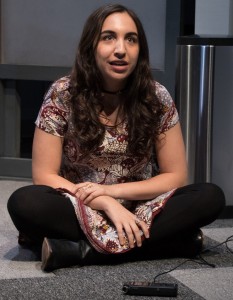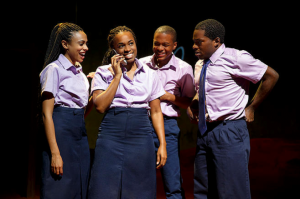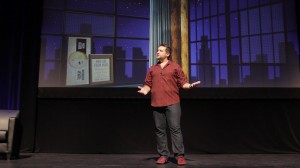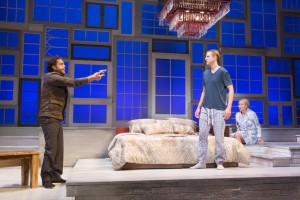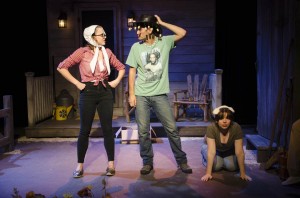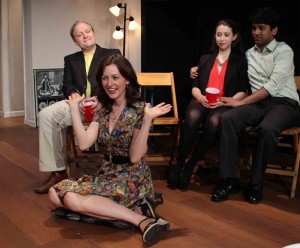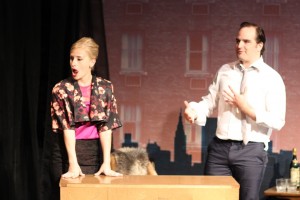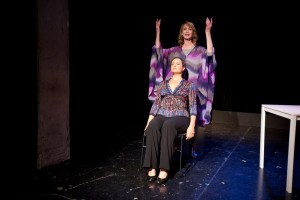Every now and then a theatrical experience comes around that breaks the mold. It’s no simple task to categorize Gideon Irving’s performance piece running at the Rattlestick Playwrights Theater. Part musical, part stand-up comedy, (very small) part magic act, and part intriguing night in a complete stranger’s living room, My Name Is Gideon: I’m Probably Going to Die, Eventually is far from a one-trick pony. On the contrary, the hour-and-45-minute show is constantly surprising audience members with laughs, gasps, songs and even snacks!
Comedy and Cabaret Cocktail
Audiences at the Broadway Comedy Club are in for some head-scratching and knee-slapping as the cast of On The Spot improvises and sings its way to creating a zany new musical performance every Monday night. The cast, made up of five singers, four improv actors and one pianist work together to create an entertaining, eclectic and somewhat perplexing hour and a half of comedy and cabaret.
Ripped From the Headlines
Kim Davies’ deftly written new play, Stet, is inspired by the hotly debated 2014 Rolling Stone article, “A Rape on Campus,” which detailed a purported gang rape on the campus of the University of Virginia. The publication later retracted its story amid accusations of poor journalistic practices.
Stet follows journalist Erika Novak (Jocelyn Kuritsky), a journalist assigned to write a story about rape on college campuses. The unsentimental Erika claims to be exhausted—“raped out” is the way she puts it—from a media saturated with similar stories, but her editor, Phil (Bruce McKenzie), challenges her to find a new way to cover the story—cutting to the heart of what really happens to the victims in the aftermath of sexual assault. The playwright herself is no stranger to the heavy topic. As an undergraduate, she attended a college with a pervasive date-rape problem. In 2014 her play Smoke was produced at the Flea Theater and received critical acclaim. Smoke took place at a bondage and fetish party.
In Stet, journalist Erika wades through endless accounts from victims as she tries to find one that stands apart from the typical “rape is bad” story. She discovers Ashley (Lexi Lapp), a college freshman with a horrific story of violent sexual assault by multiple men during her first few weeks on campus. Her accusations, ignored by the school because she didn’t file an official report, implicate a fraternity on campus.
Erika and Phil have found their hit cover story. Erika’s research leads her to Christina Torres (Dea Julien), the project coordinator for Sexual Misconduct Response and Prevention at Ashley’s college. Erika is frustrated by Christina’s confirmation that many cases go unreported to police or campus security, but Christina is adamant that her job is to support the victim in whatever course of action she wishes to pursue. Erika also speaks with Connor (Jack Fellows), the leader of “One in Four,” an activist group on campus. Connor also happens to be vice president of the fraternity Ashley claims is responsible for her rape.
As Erika becomes more invested in the piece, Ashley grows more and more concerned about the implications of speaking out against her attackers. When Ashley says she no longer wants to be a part of the story, Erika talks to Phil about presenting Christina’s personal story instead—a much more “normal” rape story involving drinking and an acquaintance.
Erika, clearly affected by the emotional nature of the piece and her own connection to the topic, must grapple with presenting a story that will turn heads and land her her first cover piece or relating a familiar tale that is often ignored. Kuritsky does a wonderful job portraying Erika’s transformation from unattached, factual journalist to emotionally involved storyteller, helped by Jo Winiarski’s straightforward set, alternating between Erika and Christina’s offices yet morphing easily into a college bar with the help of walls that double as screens. Thanks to Katherine Freer’s projections, the screens add a multimedia element to the production. Scenes from the advocacy event “Take Back the Night” play on the walls as well as text messages between Erika and Ashley.
Multiple red flags throughout her investigation give Erika pause and in the end, she must use her journalistic moral compass to decide what story she shares with the world. Will she forge ahead despite the truth and “let it stand”—literally the meaning of the Latin stet, a common term in editing journalistic copy.
Stet presents audiences with a myriad of moral questions throughout its hour and forty minute run time, which flies by due to the snappy script and smooth staging by director Tony Speciale. The supporting cast of characters really shine as well. As Christina, Dea Julien brings an immediately energetic and likable personality to the stage. There isn’t a line she throws away the entire time she’s performing—brilliantly delivering small talk and moving monologues with the same level of skill.
As Connor, Jack Fellows speaks powerful and thought-provoking dialogue while believably remaining the typical “frat bro.” McKenzie plays Phil with a frustrating lack of self-awareness and detachment.
Davies’ script is full of lines that may sound cruel or politically incorrect when they come out of the actors’ mouths, but what is so powerful is the realization that similar things are said time and time again in the national conversation around sexual assault.
Stet runs through July 3 at the Abingdon Theatre Company (312 West 36th St.) through July 3. Evening performances are at 7 p.m. Tuesday through Thursday and at 8 p.m. Friday and Saturday; matinees are Sundays at 2 p.m., and there is an additional matinee at 3 p.m. June 25. You can order online at http://abingdontheatre.org/stet/ or by calling the box office at 212-868-2055. (A portion of all ticket sales will be donated to Take Back the Night.)
Life Can Be Lethal
Compelling characters and complex questions about crime and punishment are at the heart of playwright Eduardo Ivan Lopez’s latest play, Natural Life, at the T. Schreiber Studio.
Like many of Lopez’s plays (Ribbon Creek, The Legend of Sam’s Point, Barth’s Dilemma), Natural Life draws inspiration from true stories and historical facts. Claire McGreely (Holly Heiser) has spent the majority of her adult life in prison, and now awaits execution for the murder of her husband, Virgil (Joseph D. Giardina).
In an effort to set the record straight before her death, Claire contacts network news anchorwoman Rita Hathaway (Anna Holbrook) and offers her an exclusive interview as well as the revelation that she is ending her quest for an appeal. Claire divulges to Rita that she wants to die.
But as Rita continues to speak with Claire and learns about her troubled past in flashbacks, the straight-shooting journalist’s preconceived notions about justice come into question. Jake Turner’s skilled direction keeps the action moving swiftly and clearly through the time jumps as Claire’s difficult childhood becomes achingly apparent. Sexually abused by her uncle from the age of 5, Claire was an alcoholic by age 11 and a prostitute by 14. The abuse continued when she married Virgil. Raised by her grandmother (Noelle McGrath), Claire received advice, she says, like “sex was all that men wanted. And if I was going to lie down with them, I should always get something in return.” It becomes clear that Claire is a victim as well as a killer.
Rita voices her growing belief that perhaps Claire doesn’t deserve to die to Gov. Ben Dushane (Bob Rogerson), with whom Claire’s fate ultimately lies. But the audience is confronted with the fact that a life in prison may be a more severe punishment for Claire, who explains, "My choice is death by slow deterioration or death by lethal injection, fast and, hopefully, painless. To die quickly or slowly … For all intents and purposes, my life is over."
Heiser’s portrayal of Claire McGreely is powerful and nuanced. She expertly crafts a character that has many sides and leaves no doubt that her case is not a simple one of black-and-white murder. Even more impressive is Holbrook, who creates an instantly likable and admirable character in Rita Hathaway. Her Rita looks as if she could star in a popular television series—impressively smart, driven, tactful and yet endearingly human.
The cast is rounded out by television station executive Dan Coleman (Don Carter) and prison guard Harris (Joseph Calderone). Carter provides the only comic relief throughout the play with his portrayal of a pompous, deceptive (“Well, technically, I guess I lied”) businessman with whom Hathaway must contend. The seven-person cast remains on stage throughout the performance, seated in a row of chairs behind the action, reminiscent of a jury—judging Claire’s every move.
Helping clarify the flashbacks are locations and dates of the action, displayed on screens built into the walls of an otherwise understated set by Pei-Wen Huang-Shea. The screens serve multiple purposes throughout the show thanks to sound and video design by Andy Evan Cohen. They don’t just set scenes but serve as prison surveillance cameras, office videogames for Coleman, and jail-cell television for Claire.
The intimate space, raw performances, and impressive script make for many emotional moments. The first act starts off grippingly at the climax of the story before circling back to show why Claire McGreely ended up pointing a gun at her husband.
Natural Life is thought-provoking and commanding. The subject matter is timely, and fans of recent pop-culture phenomena such as Making a Murderer, Serial and The Newsroom are likely to be riveted by this exploration of the justice system, the prison system, guilt and the media.
Natural Life plays at the T. Schreiber Studio for Theatre & Film (151 West 26th St., 7th Floor) through April 2. Tickets may be purchased for $20 general admission by calling the box office at 212-352-3101 or online at www.tschreiber.org. Evening performances are at 8 p.m. Wednesday through Saturday; matinees are at 2 p.m. on March 23 and 30.
Waterlogged Ethics
March 8th, 2016
Yes—there’s really a pool on stage at Red Speedo, the new play by Lucas Hnath (The Christians) at the New York Theatre Workshop through March 27. The pool is certainly an achievement for scenic designer Riccardo Hernandez, since it immediately places the audience in the natatorium where swimming stud Ray (Alex Breaux) awaits the following day’s Olympic trials.
But the lane of serene blue water that spans the forestage stands in stark contrast to the murky ethical dilemmas that Hnath examines. Ray’s future as an Olympic swimmer and Speedo-sponsored star are threatened by a dependence on performance-enhancing drugs; a brother whose financial well-being is inextricably tied to Ray’s success; an ex-girlfriend whom he desperately wants to marry; and a coach who is also looking for his piece of the glory.
Ray’s brother, Peter (Lucas Caleb Rooney), is a lawyer who yearns to quit his job and play full-time agent to his younger sibling. He’s willing to do whatever it takes to get his cut from the Speedo deal he has negotiated—even if it means turning a blind eye to Ray’s reliance on HCG—a synthetic testosterone classified as a performance-enhancing drug.
Ray’s ex-girlfriend Lydia (Zoë Winters) is bitter and angry after losing her license to practice sports psychology when she dabbled in the realm of pharmaceuticals. Peter helped get her convicted after speaking to the prosecution and relaying private information.
Ray’s coach (Peter Jay Fernandez) tries to take the ethical high road when he discovers what he believes are another swimmer’s drugs in his office refrigerator. But when he realizes they belong to his star pupil, he quickly changes his tune.
Then there’s Breaux as the athlete himself. The actor does a wonderful job portraying a character with more depth than meets the eye. Though Ray appears to be unintelligent and inept at grasping complex scenarios, it’s quickly evident that he’s not as dumb as he seems. Even his hideously large back and leg tattoo of a sea serpent is his own stroke of quasi-genius: “Just thought it would be good for publicity and stuff, because we all kinda look the same when we swim, because we all have goggles and swim caps, so I thought it would be a good idea to make myself really easy to spot, so like when I’m swimming, and they have the camera overhead watching us swim, it’s really easy to know which one I am, and everyone will be like ‘Whoa, who’s that guy with the sea serpent, he’s awesome.’” He is scared to fail and scared of what it will take to win, which results in his saying to Peter, Lydia and Coach exactly what each wants to hear—even if it isn’t true. But even though he’s a pawn in their endgames, he’s playing them too.
Director Lileana Blain-Cruz keeps Hnath’s script moving quickly, though the snappy, rapid-fire dialogue sometimes seems forced. It’s unclear if the choppiness is due to directing or acting choices. The script really soars when each character has a longer chance to speak—granting the audience a look inside their psyches. The air horn signifying changes in scene, however, does little to aid the audience, aside from causing them to jump.
For the most part, Rooney makes Peter deliciously deplorable. And while the rest of the cast hold their own, there’s nothing spectacular about their characters. What is spectacular is a climactic fight scene between Peter and Ray, choreographed by Thomas Schall, that takes full advantage of Hernandez’s set.
Hnath’s writing leaves no clear protagonist and offers no ethical calls throughout the 80-minute intermission-less production. Rather, he leaves the audience to ponder that all-too-gray area between right and wrong, good and bad.
Lucas Hnath’sRed Speedo plays through April 3 at the New York Theatre Workshop (79 East Fourth St.). Evening performances are at 7 p.m. Tuesday, Wednesday and Sunday; at 8 p.m. Thursday through Saturday. Matinees are Saturday and Sunday at 2 p.m. Tickets may be purchased by calling the box office at (212) 780-9037 or visiting nytw.org.
Uganda Comes to New York City
In 2005, Griffin Matthews made the nearly 7,000-mile journey from the skyscrapers of New York City to the hills of Uganda to become one of the many American volunteers looking to “find themselves” and “change the world” by building schools in Africa. Now, Matthews stars in a musical about his journey and in doing so, brings the lives of those in Uganda to a New York City stage. Sound a little cliché? Perhaps it is, but Invisible Thread is a feel-good story brought to life by a clever script, catchy score, uplifting message and talented cast.
Co-written by Griffin Matthews and real-life partner/composer Matt Gould, Invisible Thread began as a piece titled Witness Uganda which won the Richard Rodgers Award for Musical Theater in 2014. Griffin was a struggling actor booted from his church’s choir for being gay when he made the decision to leave his boyfriend Ryan (Corey Mach) behind to sign on as a volunteer. Instead of simply extolling this decision, Invisible Thread calls into question the reason that people perform altruistic deeds in the first place. Is it to help others or to help ourselves feel good? And does the motivation really matter if there is good coming from it?
Through self-deprecating humor and witty lines, both Ryan and Griffin acknowledge their somewhat stereotypical problems. “Imagine, a gay in the tenor section!” Upon arriving in Uganda at the compound where he will be building a school, Griffin meets a woman who is ironically named Joy (Adeola Role). She has built up a wall to protect herself from the constant stream of volunteers who she has learned she will never see again despite their promises. Griffin also meets Jacob (Michael Luwoye), Joy’s brother who works at the compound. They quickly form a bond and Jacob reveals what is really going on with all the schools the volunteers are building. Pastor Jim, who we never meet, immediately sells them for a profit once the volunteers leave.
Looking for answers, Griffin follows Jacob to the market, where he encounters and befriends four teenage orphans—Ronny (Tyrone Davis, Jr.), Grace (Kristolyn Lloyd), Eden (Nicolette Robinson) and Ibrahim (Jamar Williams). Discouraged by the news that his volunteer efforts with the school will result in no real change, Griffin decides that he will instead teach these four teens and Jacob in an abandoned library. As things progress, Griffin realizes that he may be in over his head. His relationships with the students and his determination to make a difference strengthen despite the obstacles.
Throughout the musical, contemporary songs mix with ones of a more Sub-Saharan styling but all are catchy and moving. The choreography by Sergio Trujillo and Darrell Grand Moultrie complements the music wonderfully and adds an energy and power to the performance that is further enhanced by stunning, soulful vocals from the ensemble. A dirt stage is slightly mismatched with the two projection screens, calling attention to the differences between New York City and Uganda.
Diane Paulus directs a talented cast with Role delivering a standout performance as Joy. Mach does what he can with the role of Ryan, though the character seems somewhat less developed than it could be and appears to be an evolving piece in the script based on previous iterations of the production. The climax in the second act seems somewhat muddled, though everything comes together in the end, perhaps too perfectly to properly portray the complicated topics addressed. Invisible Thread is a production which is clearly a result of passion and purpose but it manages to avoid becoming preachy or self-promotional.
Invisible Thread is playing at Second Stage Theater (305 West 43rd St. between 8th and 9th Aves.) through December 27. Tickets range from $69-$125 and can be purchased by calling 212-246-4422 or visiting www.2st.com.
An Interplanetary Love Odyssey
Is Peter Story, the star of Men Are From Mars, Women Are From Venus Live!, an actor or a stand-up comedian? Audience members may be surprised to find that although Story uses his real name, he is in fact performing a scripted one-man play at New World Stages.
Men Are From Mars, Women Are From Venus Live! tells the story of a man, named Peter Story, whose life was changed when he saw author John Gray speak about his best-selling book by the same name. This life-altering book explains many of the differences between men and women in the hopes of making married couples throughout the world more in-sync with their feelings. Story intimately shares with the audience how the lessons from this book have affected his marriage. With perfectly-timed jokes, hilarious physical comedy and a laugh-out loud funny script—Men Are From Mars, Women Are From Venus Live! is raucous in its relatability.
Though the stage is set with a couch, end table and stool—none of it is necessary. Story needs no lights, no set and no soaring orchestrations to have everyone in the audience nodding in understanding, clapping in collusion and laughing along with his illuminating realizations about relationships. The two-hour show flies by with a broad range of topics—from vulnerability to trust to things done behind closed doors. As the story is told by a man, the show may focus a little more on the irrational ways women behave (“I have nothing to wear”) but it is all done in an extremely tasteful manner.
However, the author of the book is not to be upstaged by Story. Gray makes a cameo appearance in two video clips shown during the play and these videos are two of the most brilliant moments of the evening.
First, Gray explains how serotonin and dopamine levels differ in men and women and cause different reactions to stress. Gray simplifies a complex scientific explanation with the help of extremely clever animations.
Second, Gray tackles the “points system” used by women. A bouquet of roses equals one point to signify a nice action by their spouse. A single rose also equals one point. And women also award themselves points throughout the day, making it harder for a Martian to measure up.
The evening isn’t all jokes though. A touching moment comes when Story reflects on the instant he knew he would marry his partner. Gray’s videos are truly informative and educational. And while the audience can laugh at Story for his error in asking his wife, “Do you think maybe it’s that time of the month?,” the true value of Men Are From Mars, Women Are From Venus Live! is in challenging men and women to think about their relationships in a smarter, more attentive way. Relationships will never be perfect but they should always be a priority.
Men Are From Mars, Women Are From Venus Live! is running at New World Stages (340 West 50th St. between 8th and 9th Aves.) in Manhattan through Nov. 29. Performances are at 8 p.m on Nov. 12, 14, 19, 21, 23, 25 and 28 and at 7 p.m. on Nov. 15 and Nov. 29. Tickets are $79. To purchase tickets, call 212- 239-6200 or visit Telecharge.com.
Not So Perfect, Definitely Absurd
In Laugh It Up, Stare It Down we are introduced to Joe (Jayce Bartok), who convinces Cleo (Katya Campbell), a woman he’s just met, that their encounter is a pivotal crossroads. This should definitely end in Cleo joining Joe for coffee, he posits. Cleo resists, claiming that she’s already met her “romantic crossroads”—a man named George. By the next scene, however, Cleo and Joe have been dating for two weeks and there’s never another mention of poor George. Not surprisingly, this isn’t the last brush with unfaithfulness in this play written by Alan Hruska and directed by Chris Eigeman.
The rest of the play follows in much the same way as these first two scenes. A plot is introduced, questions are raised, and then the story jarringly jumps to a point in the future, leaving the audience to wonder how exactly the couple got from point A to point B. From their first encounter to their looming demise when a hurricane strikes their town on Rhode Island, Laugh It Up, Stare It Down offers snapshots of climactic times in the couple's lives.
An absurdist play, Laugh It Up, Stare It Down is consistently zany. In one scene, Cleo and Joe’s baby is misplaced by a befuddled nurse before being found and returned to the nursery. In another scene, they sit down for dinner at a restaurant with blank menus and one entrée option. Unfortunately, scenes like this, though entertaining in their wackiness, detract from the script's more thought-provoking and philosophical side.
Bartok and Campbell realistically portray a couple navigating difficult situations and raising important questions like whether or not romantic love exists, or is merely an illusion killed by “a bit of intimacy.” Are they ready for children? Can they overcome infidelity? Can they maintain “ecstatic” love when life becomes routine? How will they feel when the end is near? All of the conversations revolving around these momentous milestones in their relationship create more questions still.
Bartok and Campbell are buoyed by Amy Hargreaves and Maury Ginsberg who play a variety of supporting characters and really add charm to the show with the different personalities they create. Hargreaves is moving as Alberta, vindictive as Dorothy and hysterical as the Waitress and Nurse Leaving. Ginsberg is detestable as Stephen, intriguing as Arturo and hilarious as Chalmers. It’s truly a treat to watch the supporting actors as they display their acting range.
The biggest standout of the night was the creative team behind Laugh It Up, Stare It Down’s ambiance. Kevin Judge's scenic design, Jennifer Caprio's costume design, Matthew J. Fick's original music and Peter Salett's sound design impressed throughout, but never more-so than during the final scene. A chandelier becomes a buoy, lighting and sound portrays a dark night out at sea, and the result is truly mesmerizing.
If you want a play that doesn’t require suspended disbelief, has a straightforward plot, and a standard happy ending, Laugh It Up, Stare It Down is not for you. This play creates more questions than it answers. But maybe that’s the point. Laugh It Up, Stare it Down isn’t perfect, but it’s certainly absurd—fitting for a show whose tagline is “Life Can Be Perfectly Absurd.”
Laugh It Up, Stare It Down plays through Oct. 10 at the Cherry Lane Theatre (38 Commerce Street) in Manhattan. Evening performances are at 7 p.m. on Tuesday, Wednesday, Thursday and Sunday evenings and 8 p.m. on Friday and Saturday evenings. Matinees are at 2 p.m. on Saturdays and 3 p.m. on Sundays. Tickets are between $59-$99 and can be purchased by calling 866-811-4111 or visiting Ovation Tix.
Shut Up, Sit Down, and Enjoy!
A mix between stand-up comedy show and play (it’s billed as a “plomedy”), Shut Up, Sit Down and Eat has charm, wit, laugh-out-loud humor, and a few touching, “aw”-worthy moments as well.
Four Italian Americans—three men and a woman—sit in a waiting room for a group therapy session. The only problem is, it becomes clear the shrink isn’t showing up. Instead, these four strangers trade memories and stories in their own hysterical form of therapy.
The comedy is based on a shared Italian-American experience. The three men continually bless themselves at the mention of Sinatra, bicker over the proper terminology for sauce vs. gravy, and make some off-color jokes about zeppoles. Nonetheless, non-Italians are sure to find the show wholly relatable as well, as it touches on universal themes like family, death, marriage, and sex.
The cast of four features comedians Tina Giorgi, Joe Moffa, Chris Monty, and Eric Tartaglione. These talented individuals, along with Tom Ingegno, also wrote the script. Giorgi, Moffa, Monty, and Tartaglione each bring their own style to the show, and none overshadows the others thanks to skillful directing by Eve Brandstein.
Each actor plays a character with the same name, raising the question of just how much truth lies in these vignettes. Tina Giorgi, the lone female, is fascinated by the psychological terminology in her book. Married to a Southerner, she feels utterly trapped between the two different worlds inhabited by her and her husband’s families. Giorgi delivers the most moving monologue of the production, though she is also capable of deadpanning about sperm and turkey basters at another point in the show.
The divorced Moffa recently lost his job and now must contemplate the ways of hanging himself in a basement apartment with six-foot ceilings (taping his ankles to his ass, naturally). He may be able to joke about it, but it becomes evident that he’s truly hurting—especially because of the strained relationship with his daughter, which he is at a loss to salvage.
Monty still lives at home with his parents and grandmother, but is sick of being treated like a child. He has met a girl he cares about, despite the fact that she’s Polish, so what’s stopping him from moving out and moving on with his life? Perhaps it’s the fact that his grandmother makes him great biscotti.
Tartaglione is perhaps the funniest of the four, conjuring thoughts of Danny DeVito. But, as with the rest of his castmates, Tartaglione has an impressive ability to transition seamlessly from vulgar jokes to heartfelt confessions. He is married to a woman who drives him crazy. But who isn’t driven crazy every now and then by a significant other? What really makes his performance memorable is his love for his adopted daughter, who took his last name and decided to keep it when she got engaged.
The production’s lighting subtly distinguishes the play’s action is it moves from the private thoughts of the characters to a series of individual short monologues that range from tear-jerking to gut-busting.
An intimate space lends itself to this type of show, but the sound of other productions could be heard through the Snapple Theater’s thin walls. It was an unfortunate and sometimes frustrating distraction.
Shut Up, Sit Down and Eat offers more than a few cheap mafia jokes. Audiences catch a glimpse into the relatable lives of four complex individuals—with with a countless number of hopes, fears, dreams, regrets and, most important, jokes.
Performances of Shut Up, Sit Down and Eat are Sundays at 5:15 p.m. through the end of December at the Snappple Theater Center, 1627 Broadway. The run is open-ended; tickets may be purchased here.
6 Women in Search of an Auteur
Mario Fratti’s Six Passionate Women, currently on view at Theater for the New City, concerns a creatively (and sexually) frustrated Italian filmmaker and the women from whom he seeks inspiration for his next movie. Nino (Dennis Parlato) is a cad who aims to spark his imagination by crawling into bed with multiple partners. He’s also a pied piper, with all six passionate women of the title under his spell.
Sonia (Giulia Bisinella) is trying to seduce Nino and land a leading role in his film. The motherly Valia (Donna Vivino), like Sonia, wants to see her name in lights. Nino’s wife, Marianna (Coleen Sexton), is in denial about her husband’s transgressions, though her best friend (Laine Rettmer) tries to tip her off about Nino’s infidelity. Franca (Carlotta Brentan), Nino’s loyal assistant, has fallen in love with the boss, despite her usual levelheadedness. Then Mrs. Gunmore (Ellen Barber) arrives on the scene. A rich American widow, embittered by years of living with an unfaithful husband, she promises Nino funds to produce his film. What she really wants is to lure him into creating a film that will reveal his hatred of women. As the drama proceeds, the six passionate women band together to punish Nino for the impact he has had on their lives.
With a running time of only 90 minutes, Six Passionate Women suffers from too many plot lines, too little time. The narrative is unfocused and the characters underdeveloped. Without knowing the characters sufficiently, the audience cannot care about them. There are a number of interesting scenes in the play, but Fratti leaves crucial questions unaddressed. For example, it’s clear that Nino and Marianna have a deep love for each other, despite Nino’s inability to be satisfied by one woman. How did they meet? When did he first stray? How and why has she put up with it for so long? There is a perplexing point at which the play’s focus shifts from the women manipulating Nino to make a film about his misogyny to the women making a film about hating Nino. Adding to the confusion are the facts that Fratti never convinces his audience that Nino hates women or that any of the women other than Mrs. Gunmore believe that Nino is a bad person.
Fratti collaborated with playwright Arthur Kopit and composer Maury Yeston on Nine, the 1983 Broadway musical adapted from Federico Fellini’s semi-autobiographical film 8-1/2. Nine, which garnered seven Tony Awards, concerns a blocked filmmaker on location in Venice with a number of passionate women. Six Passionate Women reportedly served as an early inspiration or template for the musical’s libretto. If Six Passionate Women is viewed as a “draft” of the musical to come, the lack of structure and focus suddenly makes much more sense.
The play, ably directed by Stephan Morrow, is well-acted by a cast of eight. (In addition to Nino and his six women, there is another man, best friend William, played by Kevin Sebastian). The production’s lighting, costumes and set are dull and uninspired. Audiences will be charmed by the performances of Parlato and Brentan, who give the production its style and verve. But they're likely to leave the theater wishing they'd spent the evening with the passionate women of 8-1/2 or Nine.
Six Passionate Women plays through Oct. 26 at Theater for the New City, 155 1st Ave., between 9th and 10th streets. Tickets can be purchased here.
70 Minutes on the Midnight Express
A stool and a water bottle.
That’s all Billy Hayes needs to weave a riveting 70-minute tale at the Barrow Street Theater.
Scratch that. Hayes didn’t create this tale with a needle and thread. The tale didn’t need to be woven. It was lived.
And this real-life story is probably more interesting than anything he could have dreamed up as an aspiring writer growing up on Long Island in the late 1960s.
In Riding the Midnight Express with Billy Hayes, the gray-haired writer, actor, director and ex-convict recounts his story succinctly, yet grippingly.
It began in 1969 with a big-dreaming twentysomething (himself) smuggling hashish from Istanbul to the United States as a quick way to make some money and finance his wanderlust. In the hard-to-recall days before the Transportation Security Administration and full-body scans, strapping marijuana to your body and walking onto a plane headed to JFK was apparently no big thing—and he was able to pull off the stunt multiple times. Until he didn’t.
Increased security in Istanbul after a terrorist attack in 1970 brought Hayes’ carefree drug-smuggling days to a grinding halt as he was searched before boarding a plane back to the United States. After removing two kilos (more than four pounds) of pot that were strapped to his body, customs officials transported Hayes to Sağmalcılar Prison, where he was sentenced to four years. Just 54 days before he was set to be released, Hayes stood before a court and was handed a life sentence (reduced to 30 years by the sympathetic judge).
So how did he come to stand before an audience on an Off-Broadway stage, telling his story to people who may have have read a book he penned or watched a film about his life? I’ll leave that to Hayes to tell you.
Given the 70-minute running time, Hayes is able to move things along without painting the picture of five years in prison with too broad a stroke. Imaginative language first depicts a young man exploring a beautiful city before portraying the far harsher scenes of life behind bars. The details that Hayes chooses to share with the audience range from eye-opening to heart-wrenching to humorous (a prison full of men being served beans every day?).
A number of times throughout the show, Hayes makes revelations that are shockingly honest and deep. While admitting to a sexual relationship with a Frenchman to a room full of strangers may have taken some guts, a more difficult concept to wrap one's head around is the thought that, at one point, Hayes found himself beginning to appreciate life in prison. It was there he was able to learn important truths about himself and life. Instead of sounding ludicrous, Hayes sounds intuitive and inspiring as he describes what it’s like to be always lonely but never alone, finding comfort and solace in yoga, and enjoying the sheer joy of existence.
While certainly not detached from the things that he speaks about, there are only a few key moments throughout the performance where Hayes is noticeably moved. By far the most emotional moment is when he recalls being asked to write his first letter home to his family.
Despite being scripted, Riding the Midnight Express does not sound overly rehearsed or robotic. No costumes, no set and no supporting cast are needed to keep the audience interested—though lighting does add an element of drama as it brightens and lightens along with the mood.
Hayes delivers a well-spoken, eye-opening, compelling and honest story—free from finger-pointing, anger or exaggeration.
Given the fact that I’m not a huge movie person and was born in the 1990s, is it acceptable to confess that before last night, I had never heard of Billy Hayes? Regardless, after seeing him tell his dramatic story on stage, I’m a little embarrassed about the admission.
But mainly I’m grateful that now I know. And instead of watching the dramatized Hollywood version, I got to hear it straight from the extremely well-spoken source.
Riding the Midnight Express with Billy Hayes plays Wednesday through Saturday at 7:30 p.m. and Sunday at 2 p.m. at The Barrow Street Theatre (27 Barrow St.). Click here for tickets.
Photo by Carol Rosegg
Bigger Isn't Always Better
It’s no wonder that with a cast of 35, the production of Nicholas Nickleby, A New Musical was forced to skimp on quality in other areas. This musical was based on Charles Dickens’ 1830’s novel and was presented by the Crummles Troupe as they tell the story of the Nickleby family. Young Nicholas Nickleby, played by the not-so-teenage looking Douglas McDonnell, is left penniless when his father passes away. Soon after, his cruel Uncle Ralph (William Broderick) sends him away to earn a living as a teacher at The Squeers’ boarding school. This “boarding school” is reminiscent of Miss Hannigan’s orphanage — poor conditions and cruel owners (played by Luba Mason and David F. Slone) shock Nicholas, and leave him with no choice but to escape with crippled boy Smike (Jonathan Fox Powers) and return home, where the family bands together against Uncle Ralph.
Unfortunately, for every strength of this production (which are quite a few), there was a disappointment. The story itself is strong, and I found myself, quite possibly for the first time ever, wanting to pick up a Charles Dickens book. However, the melodramatic way that the Crummles Troupe prides itself on presenting the plot is over the top and often downright annoying. The play within a play premise also works to make the characters one-dimensional, as you are constantly reminded that the actors on stage are playing two roles — they are not only acting as their role in Nicholas Nickleby, but acting as actors from the Crummles Troupe acting in Nicholas Nickleby.
With such a large cast, one would think the staging and choreography would have been less dull and wooden. Distracting throughout the performance were the six children who looked like they had been asked to perform the show after learning it that morning. But perhaps the most distracting weakness of the production was the make-up. Poor William Broderick. The make-up applied to make him look older was a disaster. The production also skimped on scenery and props.
The production featured original music and lyrics by Alaric Jans that worked for the time period of the show, as well as with the book by Robert Sickinger. That being said, you won’t find yourself humming along to any of these songs days later. With an ensemble of 35 strong voices blending together, the songs were often extremely enjoyable to listen to during the musical.
Though not a perfect piece by any means, Nicholas Nickleby, A New Musical, succeeds in entertaining audiences with a strong story, score and cast. Although 35 cast members may have been taking on too much, there’s something to be said for the fact that every seat in the theater was filled.
Top Photo Credit: Peter Welch Photography
The Heathers' Wrath
Heathers tells the story of misfit Veronica who suddenly finds herself accepted by the hottest, hippest group of girls in her school. Things are looking up for Veronica, with her newfound popularity and a new love interest -- the mysteriously dark and sexy new kid, Jason “J.D.” Dean (Ryan McCartan). But eventually things turn sour, and while Veronica resigns herself to fading back into obscurity or begging for forgiveness at the Heathers' feet, J.D. has other, more sinister plans for the Heathers. He wants them dead.
The show moves along wonderfully, with no dull stretches to be spoken of. Complex costumes, sets and designs are unnecessary due to the strength of the script and lyrics of the songs. Though the music isn’t anything life-changing, there are some that you’ll find stuck in your head, like “Seventeen” and “Dead Girl Walking.” The cast sings the songs well, though at times Wilbert Weed can get dangerously close to screaming the lyrics instead of belting them.
The entire show is over the top in its premise, yet the production manages to avoid becoming ridiculous and overly dramatic. A strong cast delivers hysterical lines that you’ll remember for a long time while still leaving you with some moving moments. Heathers is a wonderful 2 hours and 10 minutes where audience members can remember those high school insecurities and hormones and be thankful that they never have to go back!
Heathers: The Musical plays at New World Stages (340 West 50th Street) on Monday, Wednesday, Thursday and Friday at 8 p.m., Saturday and 2:30 p.m. and 8 p.m. and Sunday at 3 p.m. and 7:30 p.m. For more information, visit http://heathersthemusical.com.
Take a Trip Down Under
Who doesn’t love a good Aussie accent? The U.S. premiere of Australian Made Entertainment’s Once We Lived Here, with book and lyrics by Dean Bryant, music by Mathew Frank and direction by Matthew Foster, is an Australian production through and through. From the “G’Daybill” to the glossary of phrases from down under, to the actors’ accents, to the lingo, you are truly transported to the outback throughout this moving production.
Once We Lived Here has a plot that everyone can recognize — a family is brought together by unfortunate circumstances for a few uncomfortable days of pretending to have anything in common at this stage in their lives and eventually, family secrets are spilled. But despite the somewhat stale general story-arc, Once We Lived Here contains twists and turns, and character development that engulfs the audience and makes them truly care about the stories unfolding on stage.
Since their father’s tragic death, the three siblings of Once We Lived Here (Amy, Lecy and Shaun) have splintered apart. Although each of them disproves of how the others are living their lives, they all return to the family sheep station, Emoh Ruo (“Our Home”) to check in on mother Claire, who is sick and doesn’t have much time left.
Lecy, played by Morgan Cowling, is a one-time nerd who has grown up, moved to the city and hasn’t looked back. Trying to branch into the world of television, she’s accused by her siblings of only caring about material things. But as the show develops, we see that Lecy isn’t as confident as she would like the world to think. To Cowling’s credit, Lecy’s change throughout the show gradually builds until you can’t help but be moved by her.
Shaun, played by Adam Rennie, is an instantly likeable musician who hasn’t had much success. Living on the road and playing gigs, he’s never stuck to anything for too long. Memories from his past haunt him, which is extremely evident during his performance of “The Shearing Shed” (Rennie’s voice is spectacular).
Amy, played by Kathleen Foster, is the oldest and has lived at Emoh Ruo with Claire since her father’s death, desperately trying to run the farm despite a drought that won't break and finances that continue to slip. Though written as the character that would seemingly get the most understanding from an audience, Foster's portrayal of Amy left me hesitant to root for her.
As if there weren’t already enough catching up going on, in typical motherly fashion, Claire (Renee Claire Bergeron) also invites Burke (Sean Cleary) to visit. Years earlier, Burke came to Emoh Ruo to help out and fell in love with Amy. But it’s been eight years since then and Amy insists that it’s too late to rekindle the old romance.
As the week progresses and the bush fires draw closer, the family is forced to confront things that they’ve avoided for far too long. Although it may sound cliché, audience members are sure to relate to at least one character and to slowly fall in love with the folks of Emoh Ruo.
The songs are catchy, the lyrics are not too predictable, and the performances of them are stellar. Standouts included “The Shearing Shed,” “As Far As the Eye Can See” and “We Like It That Way.” There are laughs along the way, though you’ll likely find yourself wiping your eyes as well.
The set, impressive for such a small space, was used well and the lighting helped seamlessly signal flashbacks.
At some point, most people question how they’re even related to their family members. But in the end, family is family. And as Claire reminds her kids, “there’s nothing perfect out there, just what works and doesn’t work.” Once We Live Here works.
Is Ohio For These Lovers?
You’re throwing a dinner party. And you know that despite your best efforts at making sure the cheese plate and finger sandwiches are perfect, as soon as the alcohol starts flowing, the night is sure to be less than perfect.
That’s the premise for Matthew Freeman’s Why We Left Brooklyn (The Dinner Party Play). The play’s two main characters, Michelle and Jason, are a married couple hosting a dinner party to mark their departure from the Park Slope apartment they’ve inhabited for the past eight years. Jason (Andrew Schwartz) is finally throwing in the towel on his acting dreams and moving to Columbus, Ohio to become an adjunct professor. But while Jason’s feeling jaded and dejected about his original life-plan, his wife Michelle (Susan Louis O’Connor) has finally landed the book deal she’s always wanted. The plan is for Michelle to stay with their friends George, (David DelGrosso) and wife Franny (Marguerite Stimpson) to finish publicity for the book before joining Jason in Ohio. From the beginning, it’s clear that there is tension surrounding this temporary long-distance relationship.
The dinner party guests include George and Franny, former schoolmate Charlie (played by Matthew Trumbull in a delightfully quirky and endearing way), and Nicole (Moira Stone), a blunt but humorous mother of one who describes children as things which, “destroy your body, your sex life" and "turn you into an object of scorn and judgment.” But despite her insistence that twins would make her, “tear out my fucking eyes,” you get the feeling that she’s hiding a softer side behind her caustic exterior.
Also in the boxed-up Brooklyn apartment are Leanna (Sarah K. Lippmann), a wannabe writer going back to school for interior design, and boyfriend Harry (Jay Leibowitz), a chef at a popular new restaurant.
Finally, there’s Dawn (Rebecca Gray Davis) who feels unfulfilled at her job at a museum, and boyfriend Sanjeet (Imran Sheikh), an analyst who clearly isn’t in his element with this group, though he’s liked by all for his friendly, laid-back demeanor. Each character has a strong personality and a seemingly strong bond with Jason and Michelle. All except for Dawn and Sanjeet.
While the staging and blocking did nothing to draw the audience in, the dialogue was always quick and witty, though in real life I’ve never experienced an intoxicated group of individuals so adept at maintaining a single conversation.
The group dynamic was natural and despite being a two-hour play set in one room, the relatable and comedic banter kept the show moving. Throughout the three acts, the mood slowly changes as the dinner guests become drunk and as Jason’s departure draws closer. Instead of ragging on Charlie for forgetting a lime when buying Coronas or questioning the merits of yoga, the conversation switches to how the word “fresh” implies a sense of entitlement, which Jason accuses half his friends of possessing. George accuses Jason of being a quitter and giving up on his dream prematurely. Looming over conversations about President Barack Obama, Celiac Disease as the next fad diet, heirloom tomatoes and New York bagels, is the question of whether or not Jason and Michelle still want the same things in life. And what’s the difference between accepting reality, growing up and running away from your problems?
Why We Left Brooklyn is worth a visit, for the way the ensemble brings these vibrant characters to life and for the way dialogue leaves you able to tell exactly which ones you would be friends with in real life. Though certainly full of laughs, what we learn from these 10 characters’ stories is profound. Some dreams come true. Some dreams will never be realized. And sometimes, dreams change.
‘9-to-5 Clerical Poets’
Someone To Belong To, a self-proclaimed, “sweet little love story,” starts out with lyrics that are sure to cause any New Yorker sitting in the audience to nod their head in agreement. “A typical day in New York is no cause for popping a champagne cork,” sings the ensemble. Based on the book by Lori Steele and Christine DeNoon, this new musical with music and lyrics by David DeNoon, has its celebratory moments.
Set in 1963, Someone To Belong To revolves around two love stories involving four main characters. Davis (played by Chris Ware), a writer who feels he’s wasting his potential working in an advertising agency, falls for his often-frazzled but endearing secretary, Annie (played by Samantha Eggers). Unfortunately, Annie becomes engaged to cheesemaker Ted, played to comedic perfection by Jonathan Desley. Two other copywriters at the advertising agency, the strong and determined Lois (Katherine Henly) and the ladies’ man Joe (Justin Colombo) are in an open relationship. This works for the two non-committal flirts until Joe realizes he may have fallen in love. The core cast is solid but the real standout is the hilarious secretary Miss Sasslebaum, played by Carla Nager.
When Christine DeNoon’s father, David DeNoon, passed away, she had no idea that he had penned over 100 songs. Upon finding them in 2012, seven years after his death, she decided that they deserved to be heard and gathered a team to shape 11 of his songs into a musical. The show’s memorable anthem, “The Great American Would-Be Novelist,” essentially tells the story of DeNoon’s real life. A talented songwriter, DeNoon, like the character Davis, felt trapped working as a copy editor at an advertising agency.
Many of DeNoon’s songs contain clever, catchy lyrics such as “Here’s To Manhattan,” “Some Get The Bumpy” and “Don’t Bad-Mouth New Jersey” while others leave something to be desired. Christine DeNoon, who has experience in improv, certainly injects some laugh-out-loud lines to the script, though sometimes the jokes are somewhat cheesy (literally “You don’t like cheddar? But cheddar makes everything better! Hot damn I’m on a roll!”).
For a small New York International Fringe Festival production, the lighting, choreography and costumes are all commendable. Director Leslie Collins does a great job with the show, which while predictable, leaves audiences smiling as the curtain closes.
But as you understand the love-lives of Davis, Annie, Joe and Lois, you can’t help but feel that the better story already took place, when Christine DeNoon discovered her father’s binder of songs and decided to bring them to life.
Theoretical Physics for Dummies
“Do you feel like you’re in science class?” an audience member asked me as I stood in line for the restroom during the intermission of And It Spins Twice, playing as part of the New York International Fringe Festival. Shockingly, for a show set in parallel universes where three fourths of the characters are theoretical physicists discussing concepts like gravity, membranes and string theory, I did not feel like I was in science class.
It says a lot of playwright Alexis Roblan’s script, which uses clever metaphors like guitar strings and the Titanic to make these complex ideas a little easier to swallow. Instead of groaning at the mention of protons, neutrons and electrons, audience members will find themselves drawn into the two stories being told.
In one universe, Lucia Grillo plays Beth, a theoretical physicist and physics professor whose husband Ryan, played by Thom Christensen, has just left her. Grillo’s Beth is either angry or weepy throughout the show, which is understandable given her circumstances. But despite all her crying, it never really made me care.
In the other universe, a more compelling story unfolds, thanks in part to the wonderful chemistry between Marlena Kalm’s Liz (a theoretical physics graduate student) and Thom Christensen’s parallel universe version of Ryan (a singer/songwriter obsessed with the idea that somewhere out there in the vast expanse of space, another version of himself could be Bono.) The two are just starting out their relationship, which is dotted with humor. When Liz tells Ryan she’s addicted to his eyes, he retorts, “Not my hot 40-year-old-man body?” But their relationship gains a depth to it as the piece progresses and the two take on much more meaningful conversations.
In both universes, Liz and Beth are approached by June (Julia Campanelli), a “cosmologist, astrologer, author, healer and inspiration” to Beth and a world-renowned physicist to Liz. She’s convinced that Liz and Beth’s equation for predicting the collision of two universes’ membranes is correct, and that the time is now.
Director Michael Padden does a great job staging the show, seamlessly flowing between the two parallel universes with the help of lighting designer and stage manager Joe Cabrera. Though the set is not elaborate, consisting of only two tables and three chairs, it is more than adequate. The minimal set helps the audience to focus and contemplate on the questions being raised throughout the show.
And perhaps the most moving question is whether or not there is a rhyme or reason for anything. Both Liz and Beth at one point during the play wonder, “I never thought there was a plan, but there are supposed to be rules, aren’t there?”








